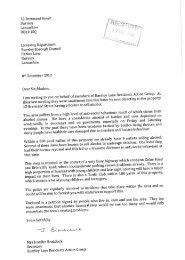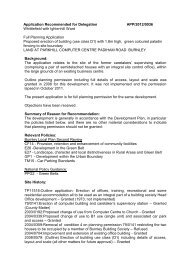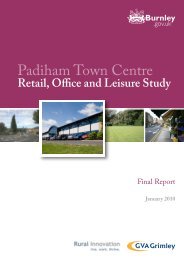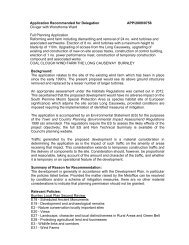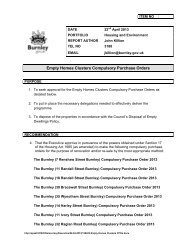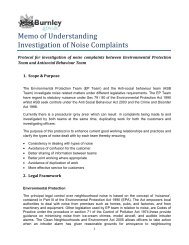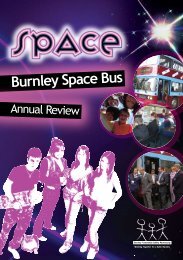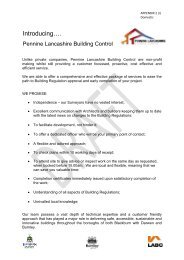BWood Appraisal.indd - Burnley Borough Council
BWood Appraisal.indd - Burnley Borough Council
BWood Appraisal.indd - Burnley Borough Council
You also want an ePaper? Increase the reach of your titles
YUMPU automatically turns print PDFs into web optimized ePapers that Google loves.
3.5.32.Additionally, there has been severe deterioration of the southern part of OxfordRoad, which served as a vibrant local centre for <strong>Burnley</strong> Wood, with loss of quantity,quality and variety of retail outlets. This, along with lack of investment, vacancy andunsympathetic alterations, has had a major adverse impact on the character andappearance of the area, which lies within the Conservation Area, and on theavailability of local services, facilities and employment for the remaining community.Facelifting - Oxford RoadRear extensions and other improvements- Pine Street3.5.33. Over the last few months improvements works havebegun in the core of the NAP area. The initial works haveinvolved “face-lifting” to the exterior of terraced blocks andthe stone cleaning and newly painted window and doorsurrounds has an immediate effect on the streetscene,re-inforcing the character of the area (Plan F - shows theblock 3-17 Clarence street for Heritage enhancement tocomplement these improvements).3.5.34. To the north of the area, beyond Parliament street,several streets were refurbished in the 1990ʼs as part ofthe Central Area Renewal Area Initiative. The improvementsincluded stone cleaning and rear extensions which enhancedthe character of the area. The houses remain in reasonablecondition with low vacancy rates (Part of this area is shownon Plan F for further heritage enhancement works to thestreet environment).3.5.35. The area between the canal and the railway, in thewest of the NAP area, has seen the most change althoughthe buildings adjacent to the canal still remain. Healey WoodMill, Healey Wood Brick Works and the terraced streetsbetween the mills and the railway have long been demolished.Only twoterraced blocks remain, one on Marlborough Street and one immediately south ofHealey Royd Mill (Hughes Street). Some small workshops in the south west corneradjacent to the railway also remain. Much of this cleared land has been redevelopedwith modern single storey portal framed industrial units and some land is used forsurface parking or is poor quality grassed open space (see Plan F - UnsympatheticChanges). However, there is still evidence of the original street pattern and afootpath retains links with the Healey Wood Road railway bridge with its stone wallsand cobble stone road surfaces (See Plan F - Key routes and traditional streetpatterns).The remaining mills adjacent to the canal are described in 3.5.8-11 above but somechange has taken place in this area – two modern units have replaced one of theFinsley Mill buildings on Finsley Gate (see Plan F - Unsympathetic Changes) and asurface car park has been created where back to back houses have been demolishedon Exmouth Street. Part of Albion Mills has also been demolished and a landscapedwalkway created to give access to the canalside. The Centenary Way flyover forms aboundary to this corner of the NAP and is dominant and unsympathetic (see PlanF - Unsympathetic Changes). Although these changes and recent fire damage tothe garage fronting Finsley Gate have eroded the character of the area, Finsley Milland Albion Mill retain their character and play a key role in defining the edge of theCanalside Conservation Area.3.5.36. In the area to the east of the canal straight mile theindustrial premises are mostly still in active use but many of thebuildings have been significantly altered. Dean Mill and part ofthe former Livery Stable have been sympathetically refurbished(See 3.5.13). Although part of Plumbe Street Shed remains, theformer single storey weaving shed has been demolished and thecleared site is in poor condition and attracts fly tipping. Parts ofSpring Garden Mill have been rendered with little respect for thehistoric character of the area and part of the site of the formerlivery stables buildings has been developed unsympathetically.Plan F identifies the areas around these buildings for heritageenhancement.3.5.37. The Mills adjacent to the River Calder are leastunchanged although significant change has taken place onthe Todmorden Road frontage where Spa Field Mill and, morerecently, Fulledge Mill have been damaged by fire (seePlan F - Unsympathetic Changes). The Spa Field Mill site hasbeen redeveloped with modern buildings but part of the singlestorey mill wall remains and along Springfield Road helps tomaintain the character of the <strong>Burnley</strong> Wood Conservation Area(See Plan F - Feature of Local Heritage Value). The newbuilding adjacent to Springfield Road, although modern andglass fronted has retained sections of the stone wall at thecorners and its roof line appears to pay some respect to theform of the north-light roof structure of the former building.Fulledge Mill, although it has been adapted for use, still hasthe appearance of a derelict building and a car wash businesshas been created on part of the site. Parts of <strong>Burnley</strong> Wood Millhave also undergone unsympathetic alterations on the western,southern and eastern elevations where painted rendering,modern windows and a breeze block wall detract from the characterof the area. The Parliament St gable of Oxford Mill hasalso been unsympathetically rendered and painted(see Plan F - Unsympathetic Changes).Although some buildings are unchanged they may be at riskthrough underuse and neglect or inappropriate uses.3.5.38. Redevelopment has given the opportunity to introducesome much needed greenery into the area around housing,industry and on open spaces.Redevelopment on part of the liverystables siteSpring Garden Mill from Craven StreetFormer Spa Field MillRemains of Fulledge MillBackground Image: Healeywood Mill[L]31 heritage appraisal heritage appraisal 32



